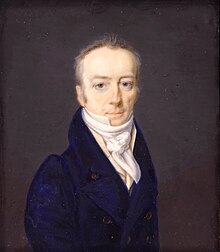James Smithson | |
|---|---|
 James Smithson by Henri-Joseph Johns, 1816 | |
| Born | Jacques-Louis Macie c. 1765 |
| Died | 27 June 1829 (aged 64) |
| Burial place | Smithsonian Castle, Washington, D.C. |
| Nationality | British |
| Alma mater | Pembroke College, Oxford |
| Occupation(s) | Chemist, mineralogist |
| Known for | Founding donor of the Smithsonian Institution |
James Smithson FRS (c. 1765[1] – 27 June 1829) was a British chemist and mineralogist. He published numerous scientific papers for the Royal Society during the early 1800s as well as defining calamine, which would eventually be renamed after him as "smithsonite". He was the founding donor of the Smithsonian Institution, which also bears his name.
Born in Paris, France, as the illegitimate child of Elizabeth Hungerford Keate Macie[2] and Hugh Percy (born Hugh Smithson), the 1st Duke of Northumberland, he was given the French name Jacques-Louis Macie. His birth date was not recorded and the exact location of his birth is unknown; it is possibly in the Pentemont Abbey.[3] Shortly after his birth he naturalized to Britain where his name was anglicized to James Louis Macie. He adopted his father's original surname of Smithson in 1800, following his mother's death. He attended university at Pembroke College, Oxford in 1782, eventually graduating with a Master of Arts in 1786. As a student he participated in a geological expedition to Scotland and studied chemistry and mineralogy. Highly regarded for his blowpipe analysis and his ability to work in miniature, Smithson spent much of his life traveling extensively throughout Europe; he published some 27 papers in his life.[4]
Smithson never married and had no children; therefore, when he wrote his will, he left his estate to his nephew, or his nephew's family if his nephew died before Smithson. If his nephew were to die without heirs, however, Smithson's will stipulated that his estate be used "to found in Washington, under the name of the Smithsonian Institution, an establishment for the increase and diffusion of knowledge among men". He died in Genoa, Italy, on 27 June 1829, aged 64. Six years later, in 1835, his nephew died without heir, setting in motion the bequest to the United States. In this way Smithson became the patron of the Smithsonian Institution in Washington, D.C., despite having never visited the United States.
- ^ "Smithsonian History, James Smithson". Smithsonian Institution Archives Website. Smithsonian Institution Archives. Retrieved 28 February 2018.
- ^ Cite error: The named reference
SIAmainwas invoked but never defined (see the help page). - ^ Ewing, Heather (2010). The Lost World of James Smithson: Science, Revolution, and the Birth of the Smithsonian. AC Black. Ch. 1, note 35. ISBN 9781408820759.
- ^ Colquhoun, Kate (31 May 2007). "A very British pioneer". The Telegraph. Retrieved 7 May 2012.